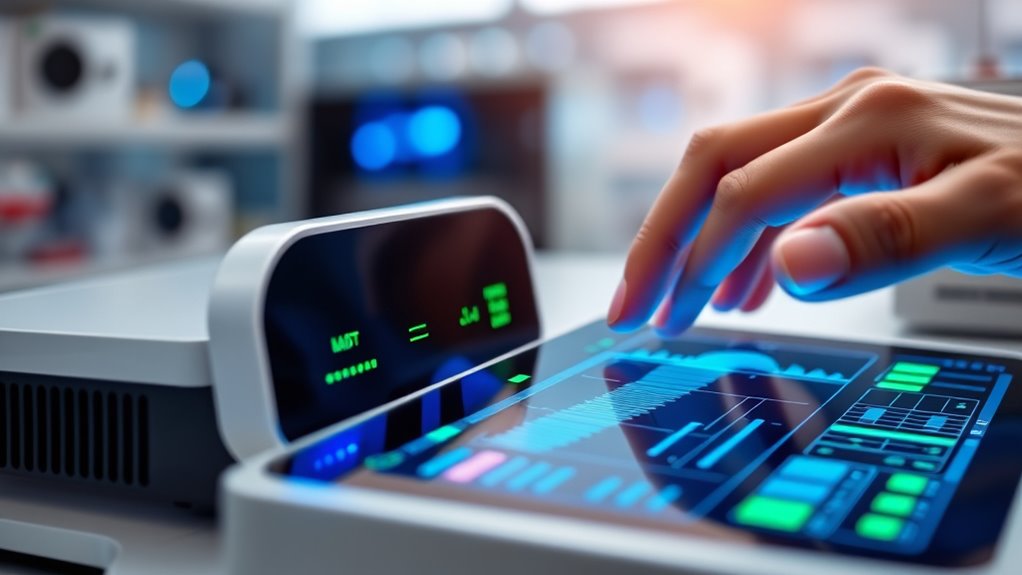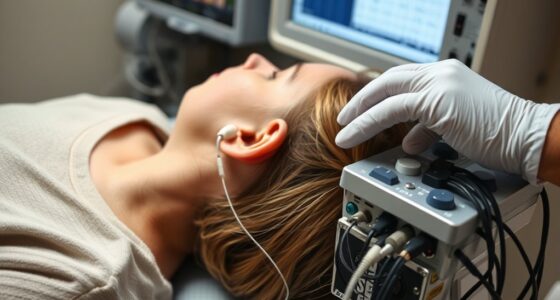Yes, you can train your ears with new auditory training programs that use advanced technology and personalized exercises. These programs leverage neuroplasticity to improve sound discrimination, speech understanding, and listening skills, even for those with hearing challenges. They often include interactive features, real-time feedback, and immersive environments to boost your listening abilities over time. Keep exploring, and you’ll discover how these innovative methods can help you hear better and understand more easily.
Key Takeaways
- Yes, targeted auditory training programs leverage neuroplasticity to improve sound discrimination and listening skills.
- Advanced technologies like adaptive algorithms and real-time feedback personalize training for better outcomes.
- Auditory training enhances speech understanding, especially in noisy environments, benefiting individuals with hearing challenges.
- These programs can improve musical perception, environmental awareness, and overall communication abilities.
- Ongoing innovations and success stories demonstrate that ear training effectively boosts listening skills across various populations.
Understanding Auditory Training and Its Origins

Although auditory training has been around for decades, its origins trace back to early efforts to improve hearing and communication skills. Initially, sound therapy was used to help individuals with hearing impairments enhance their auditory development. These early programs focused on stimulating the ears and brain to better process sounds, laying the groundwork for modern auditory training. Over time, practitioners recognized that targeted exercises could strengthen listening abilities, especially in noisy environments. Today, auditory training involves structured activities designed to refine your sound discrimination and comprehension. While technology has advanced, the core idea remains the same: through consistent practice, you can retrain your brain to interpret sounds more effectively, improving overall communication and listening skills. Additionally, auditory training in education is increasingly being integrated into classroom settings to support diverse learners and enhance their listening capabilities. Research shows that neuroplasticity plays a significant role in the success of auditory training programs, highlighting the brain’s ability to adapt and improve with dedicated practice. Engaging in these programs leverages the brain’s inherent capacity for brain adaptability, making improvements possible at any age. Furthermore, understanding how auditory processing functions within the brain helps tailor more effective training methods. Recognizing the importance of sound discrimination training can further optimize auditory rehabilitation strategies.
How Modern Programs Are Changing Our Listening Abilities

Modern auditory training programs are revolutionizing how you enhance listening skills by integrating advanced technology and personalized approaches. These programs improve sound localization, helping you identify where sounds originate with greater accuracy. They also boost musical perception, allowing you to enjoy richer, more nuanced listening experiences. By tailoring exercises to your specific needs, modern programs adapt to your progress, making training more effective. Interactive software and real-time feedback enable you to sharpen your ability to distinguish subtle differences in sounds and locate sources in complex environments. This innovative approach not only strengthens your auditory skills but also enhances everyday listening, whether you’re in noisy settings or enjoying music. Incorporating elements of bedroom design into auditory training environments can create a calming and focused space conducive to learning. Additionally, understanding the vetted methods behind these programs ensures that users receive safe and effective training tailored to their needs. The use of personalized training plans further optimizes the development of auditory perception, ensuring that each individual receives targeted exercises for maximum benefit. Implementing evidence-based techniques can significantly improve training outcomes and ensure lasting benefits. Recent research also highlights the importance of neuroplasticity in auditory training, emphasizing the brain’s ability to adapt through targeted exercises. Overall, these programs are transforming how you develop and refine your auditory perception.
The Science Behind Sound Discrimination Improvements

Have you ever wondered how auditory training enhances your ability to distinguish subtle differences between sounds? The answer lies in neural plasticity—the brain’s remarkable ability to adapt and reorganize itself. When you engage in training, your brain rewires neural pathways, improving how it processes sound frequency. This adaptation sharpens your auditory discrimination skills, allowing you to pick up on nuanced pitch variations and subtle tonal changes. As you practice, your brain becomes more efficient at encoding sound information, making it easier to differentiate similar sounds. This process isn’t just about hearing; it’s about meaningful neural changes that enhance your listening ability. Essentially, auditory training harnesses neural plasticity to improve how your brain interprets and reacts to sound differences. Additionally, understanding the role of brain adaptation can help optimize training methods for better outcomes. Recognizing the importance of neural efficiency can further refine approaches to auditory improvement.
Technologies Driving Innovation in Auditory Enhancement

Advancements in technology are revolutionizing how we approach auditory enhancement, building on the brain’s natural ability to adapt through neural plasticity. New tools like digital platforms, adaptive algorithms, and virtual reality create immersive experiences for auditory training. Music therapy integrates rhythmic and melodic exercises to strengthen listening skills, while cognitive training programs challenge your brain to process sounds more efficiently. These innovations make training engaging and personalized, helping you discover hidden potential. You’ll experience rapid progress as technology tailors exercises to your needs. Imagine improving focus in noisy environments or understanding speech more clearly. The fusion of music therapy and cognitive training through cutting-edge tech empowers you to take control of your auditory health, making training accessible, effective, and inspiring. Neural plasticity underpins these technological advancements, enabling the brain to reorganize itself in response to targeted auditory exercises. Additionally, incorporating adaptive algorithms allows for customized training levels that adapt as your skills improve, ensuring continual progress and leveraging brain adaptability. This synergy enhances the effectiveness of auditory training programs by utilizing exploiting neural pathways, which is supported by recent research in auditory neuroscience.
Benefits for Hearing-Impaired and Normal Hearing Individuals

Are you aware of how auditory training benefits both those with hearing impairments and individuals with normal hearing? These programs can notably enhance your musical perception, allowing you to distinguish melodies, rhythms, and harmonies more clearly. For individuals with hearing challenges, training sharpens auditory skills, making speech comprehension easier and reducing listening fatigue. Even if you have normal hearing, auditory training can boost your ability to pick out subtle sounds in noisy environments, improving overall communication. Additionally, the training supports language acquisition by strengthening your ability to process speech sounds accurately. Regular practice can also improve your auditory discrimination, helping you distinguish between similar sounds more effectively. Furthermore, engaging regularly in auditory exercises can foster self-awareness of your listening habits and challenges, contributing to ongoing personal development. These programs can also leverage mindfulness techniques, such as focused attention and awareness, to enhance the effectiveness of auditory training. Research indicates that consistent auditory training can lead to measurable improvements in listening skills over time. These benefits extend to enhancing cognitive functions related to auditory processing, making daily listening tasks more manageable. Whether you’re seeking to refine musical skills or enhance everyday listening, these programs offer tangible benefits for a wide range of hearing abilities, making your auditory experience richer and more precise.
Real-Life Success Stories and Case Studies

Real-life success stories highlight the transformative impact of auditory training programs on individuals’ lives. You’ll hear how people improve musical training skills, enabling them to enjoy music more deeply. Others share breakthroughs in language acquisition, breaking down communication barriers. For example, someone who struggled with understanding speech in noisy settings now confidently engages in conversations. These programs have helped many regain confidence and reconnect with loved ones. Additionally, some participants experience enhanced listening skills, which significantly improve their overall communication and quality of life. Developing auditory processing can lead to better comprehension in diverse settings. Such improvements are often supported by brain plasticity, allowing the brain to adapt and strengthen auditory pathways through targeted exercises. Moreover, understanding how neuroplasticity works can motivate individuals to stay committed to their training routines. These advancements are further bolstered by the emerging role of data-driven strategies in customizing effective training protocols.
Auditory training transforms lives, improving musical skills, language abilities, and confidence in social interactions.
- A musician sharpens their ear, mastering complex compositions.
- A bilingual individual accelerates language learning, opening new career paths.
- Someone overcomes age-related hearing decline through tailored exercises.
- A student improves focus, leading to academic success.
- An individual regains confidence in social interactions.
These stories prove that with dedication, auditory training can truly change lives.
Future Directions and Potential Developments

Looking ahead, integrating AI technologies can make auditory training more adaptive and accessible. Personalizing training algorithms will help tailor programs to individual needs, enhancing effectiveness. Additionally, expanding clinical applications could bring these tools to a wider range of auditory health issues. Incorporating skincare solutions like Pimple Patches may seem unrelated but underscores the importance of targeted, effective treatments in health and wellness domains.
Integration With AI Technologies
As artificial intelligence continues to advance, its integration into auditory training programs promises to revolutionize how you tailor and deliver interventions. By leveraging AI, programs can adapt in real-time to your progress, maximizing neurological plasticity and optimizing results based on insights from auditory neuroscience. This synergy could lead to more effective, engaging training that responds to your unique needs and challenges. Imagine AI-powered systems that analyze your responses, adjust difficulty levels instantly, and provide targeted feedback, all fostering faster improvements. With these innovations, you may experience a deeper connection with your auditory system, reveal potential previously limited by traditional methods. The future holds exciting possibilities to make listening skills more accessible and personalized for everyone.
- Feel empowered as your progress accelerates
- Overcome obstacles with tailored support
- Experience breakthroughs in hearing and comprehension
- Witness the fusion of technology and neuroscience
- Embrace a new era of auditory mastery
Personalized Training Algorithms
Building on the integration of AI technologies, personalized training algorithms are poised to reshape how auditory interventions are tailored to your needs. These algorithms analyze your progress in real-time, customizing exercises for musical training and language learning. They adapt difficulty levels, focus on weak points, and optimize your listening experience. This targeted approach accelerates skill development and keeps you engaged. Here’s a key insight:
| Feature | Benefit | Application |
|---|---|---|
| Real-time feedback | Immediate adjustments | Enhances listening precision |
| Adaptive difficulty | Keeps challenges appropriate | Prevents frustration, boosts growth |
| Personal data analysis | Tailored exercises | Customizes musical and language tasks |
With such algorithms, your training becomes more efficient, personalized, and impactful.
Broader Clinical Applications
The future of auditory training extends beyond individual rehabilitation, offering promising possibilities for broader clinical applications. You could see improved support for children struggling with language acquisition, helping them develop stronger communication skills. These programs might also enhance musical perception, allowing individuals to enjoy music more fully and connect emotionally. In clinical settings, auditory training could become a key tool for treating auditory processing disorders and aiding stroke survivors. Furthermore, it may empower educators and therapists to tailor interventions more effectively. The potential to improve listening skills across various populations is immense, fostering greater inclusion and understanding.
- Unlocking new levels of emotional connection through music
- Accelerating language acquisition in diverse learners
- Providing hope for those with auditory processing challenges
- Transforming therapy with innovative, engaging tools
- Building a world where everyone’s voice can be heard
Frequently Asked Questions
Can Auditory Training Help Improve Speech Understanding in Noisy Environments?
Auditory training can definitely help you improve speech understanding in noisy environments. It trains your ears to better distinguish speech amid background noise, making conversations clearer. If you use hearing aids, these programs can complement their function by enhancing your listening skills. With consistent practice, you’ll find it easier to focus on conversations even when background noise is loud, boosting your confidence and communication effectiveness in everyday settings.
Are There Age Restrictions for Effective Auditory Training Programs?
Imagine it’s 1999, and you’re wondering about age limitations for auditory training. You’ll find that many programs now have broad accessibility, but some may have age restrictions due to physical or cognitive factors. However, most are adaptable, making them effective across different ages. It’s best to check specific program requirements, ensuring they suit your needs. Age shouldn’t hold you back from improving your listening skills—training is possible at any age.
How Long Does It Typically Take to See Noticeable Improvements?
The training duration varies, but most people notice improvements within a few weeks. Typically, you’ll see a noticeable improvement timeline after about 4 to 6 weeks of consistent practice. Your progress depends on how often and intensely you engage with the program. Stay committed, and you’ll likely experience clearer listening and better sound discrimination as your auditory skills strengthen over time.
Do Auditory Training Programs Require Professional Supervision?
Think of auditory training as exploring a complex labyrinth. While you might find some paths on your own, professional supervision acts like a skilled guide, ensuring you avoid dead ends. Many programs offer customization tailored to your needs, but expert oversight can optimize progress. So, yes, seeking professional supervision helps personalize your journey, making it more effective and efficient in enhancing your listening skills.
Can These Programs Benefit Individuals With Auditory Processing Disorders?
Auditory training programs can definitely benefit individuals with auditory processing challenges. If you face auditory deficits, these programs help improve your ability to interpret sounds and speech, making daily communication easier. You might see progress through targeted exercises designed to strengthen your listening skills. While professional supervision can optimize results, many programs are accessible for self-guided use, offering valuable support for overcoming processing challenges.
Conclusion
Now, as you navigate the new nuances of auditory training, you can see how these programs pioneer progress, perfecting your perception and sharpening your sound sensitivity. With continuous curiosity and consistent commitment, you’ll cultivate clearer comprehension and confident communication. Embrace the evolving excellence of auditory advancements, opening doors to better listening, brighter bonds, and boundless benefits. Your ears are enthusiastic, and with effort, they’ll excel, echoing with enhanced expertise in every echoing experience.











